Rise of Pentecostalism 1
Chris Knepp
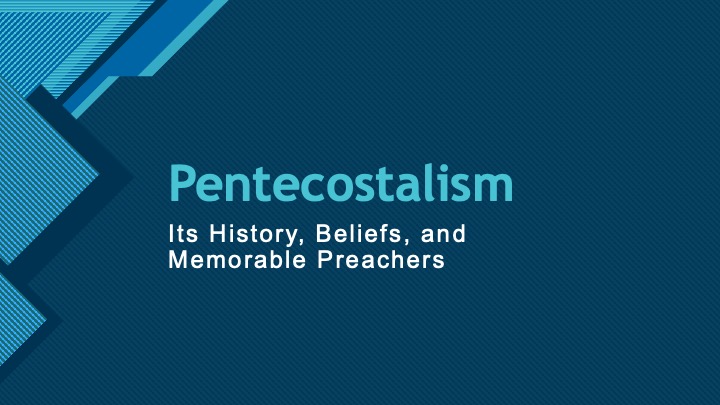
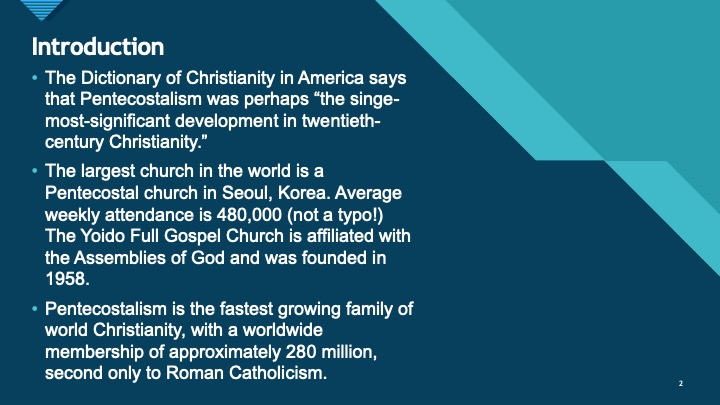
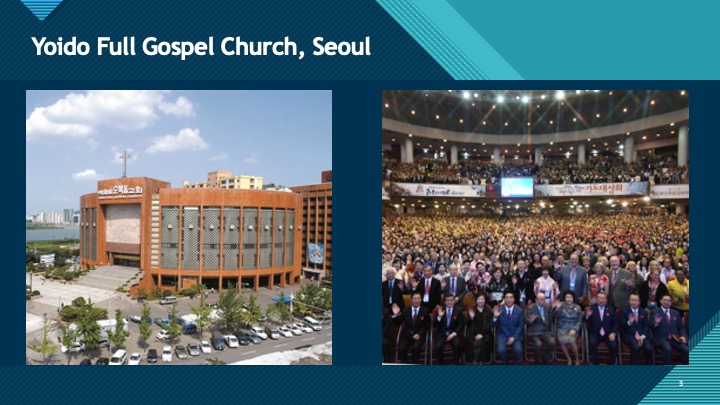
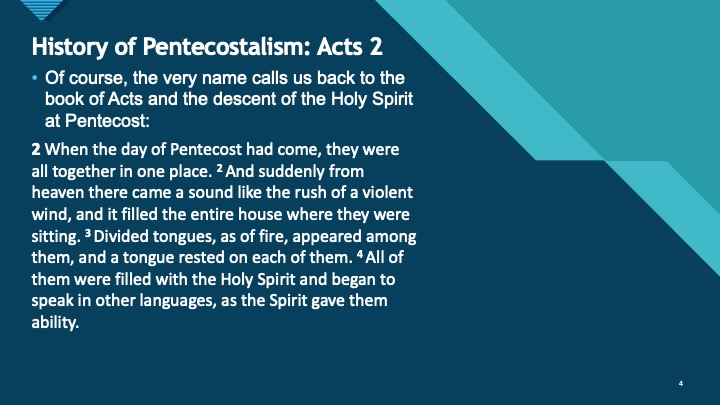
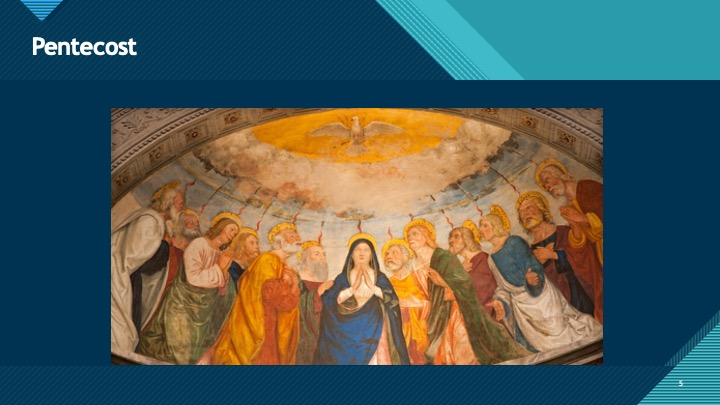
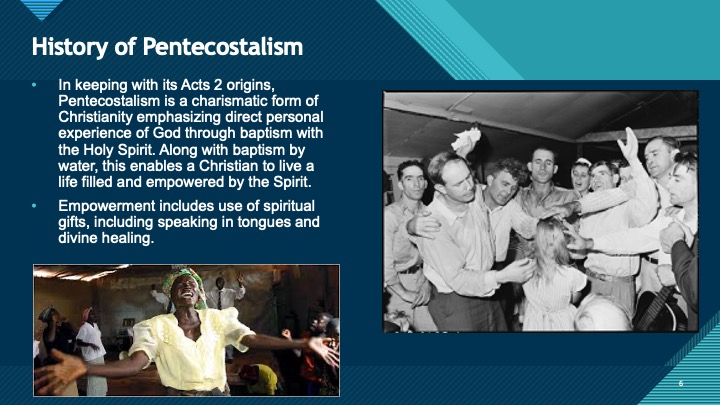
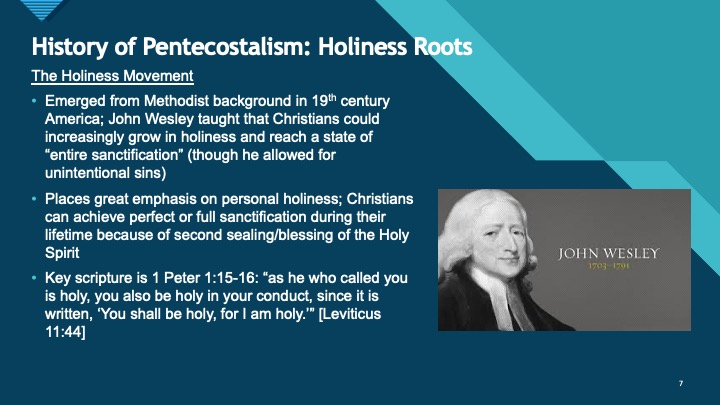
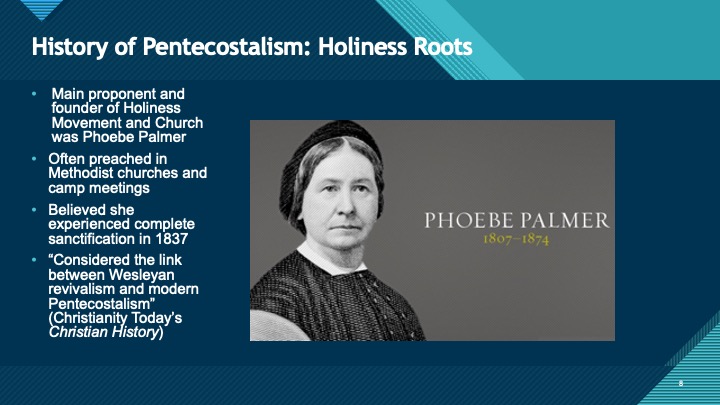
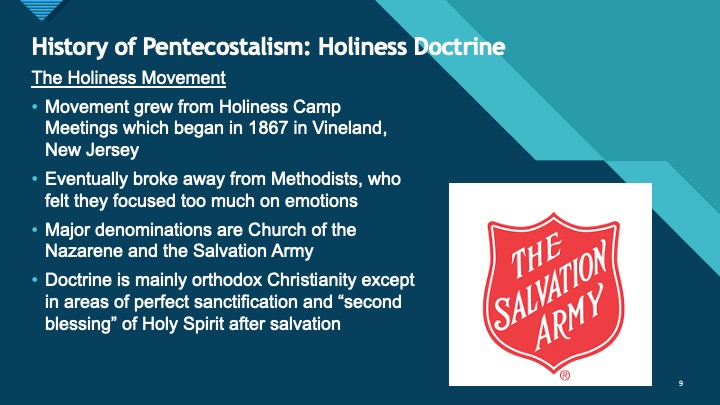
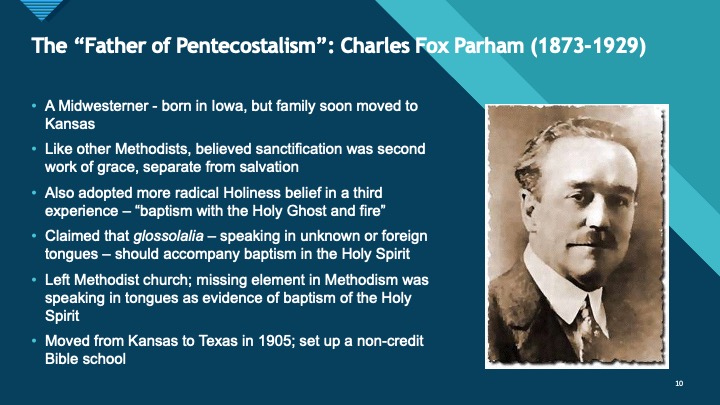
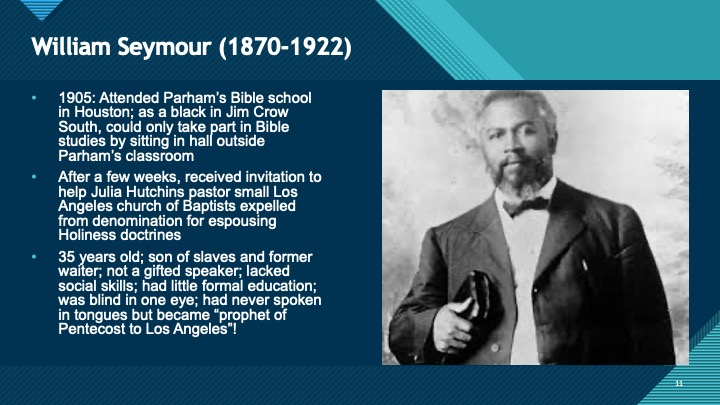
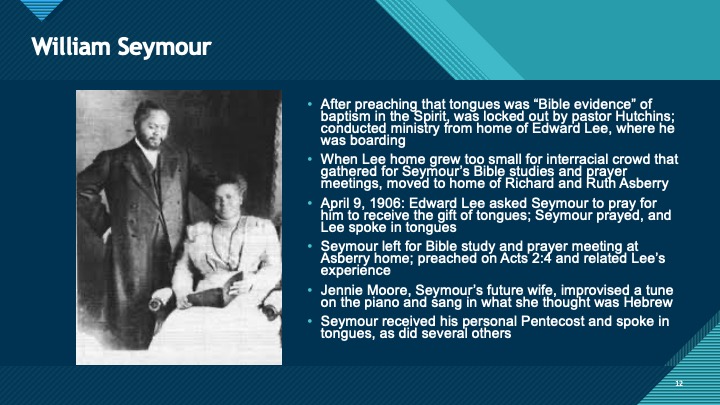
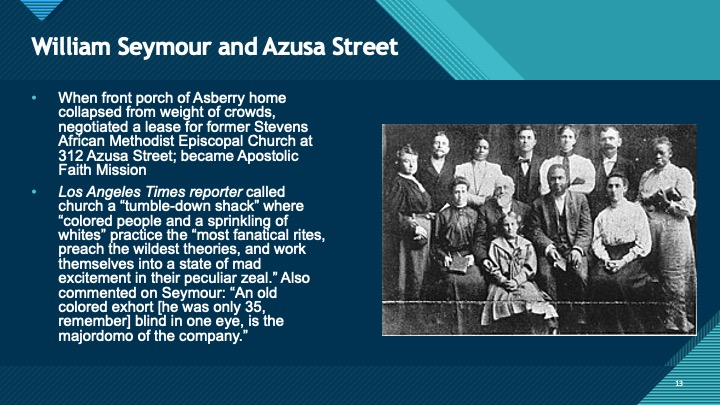
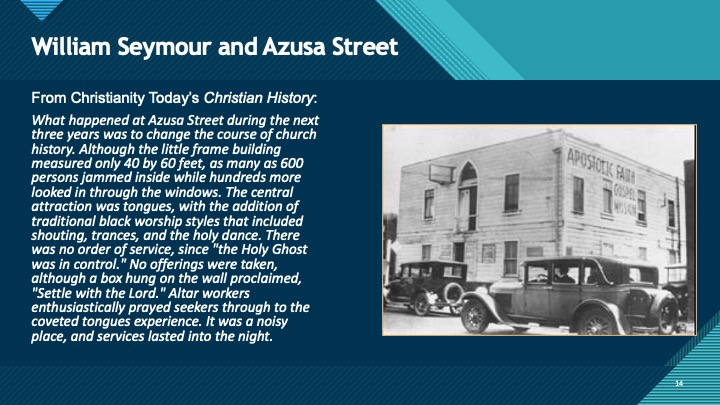
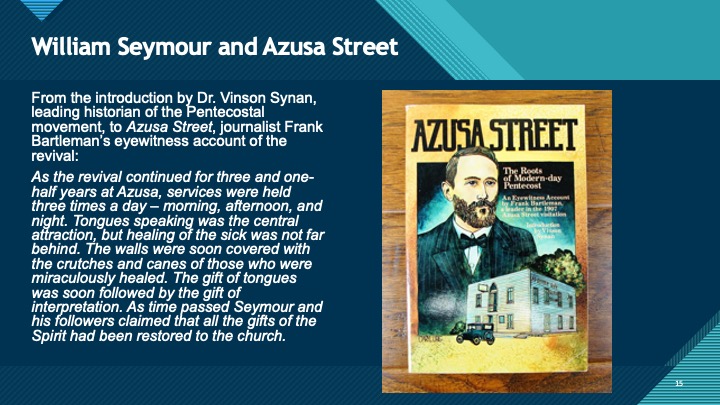
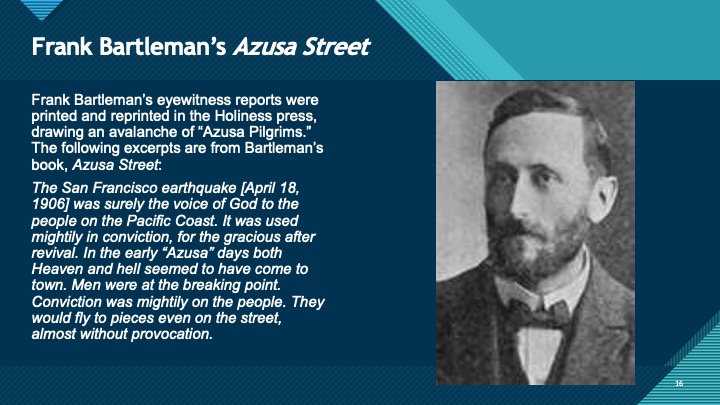
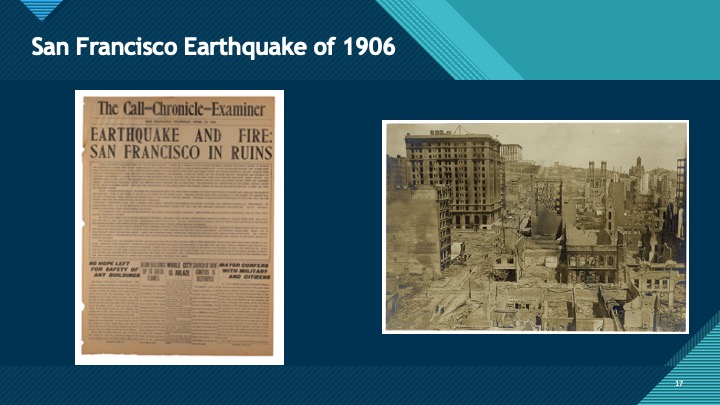
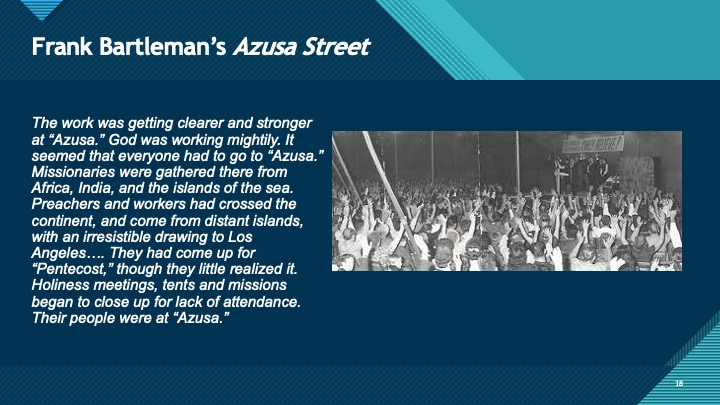
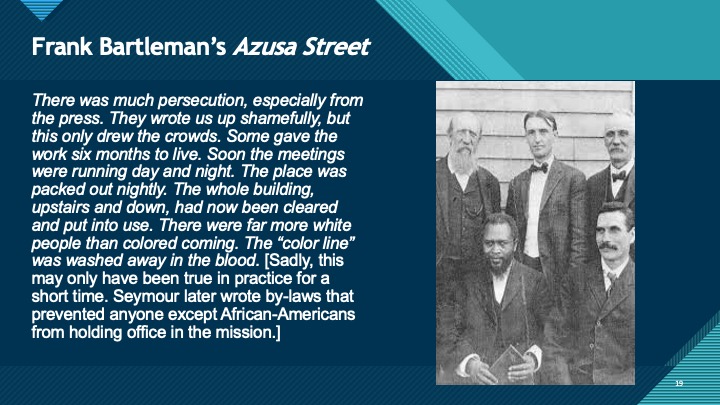
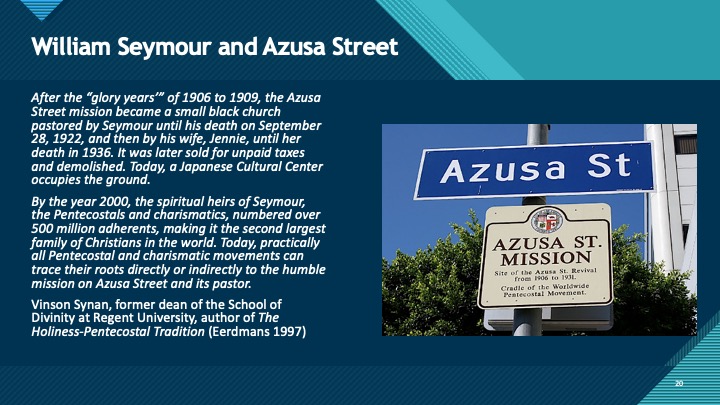
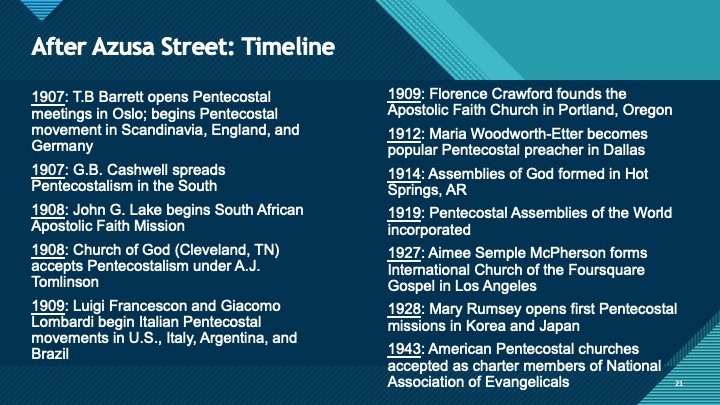
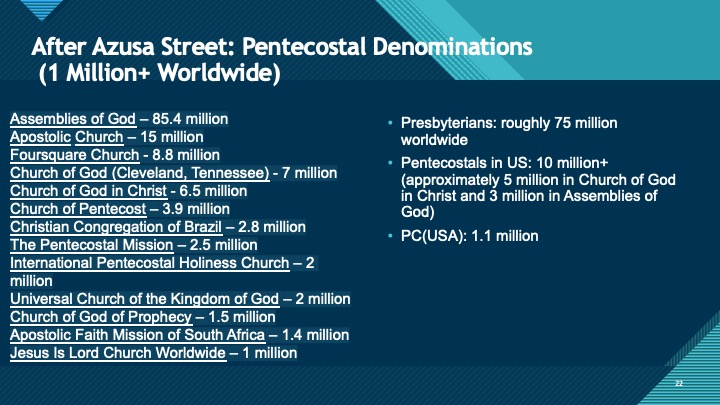
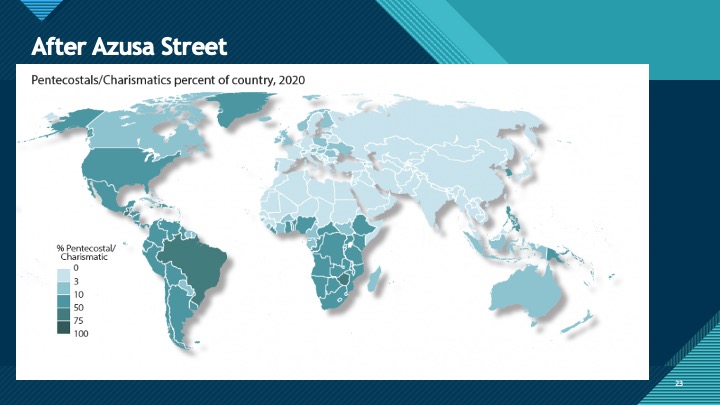
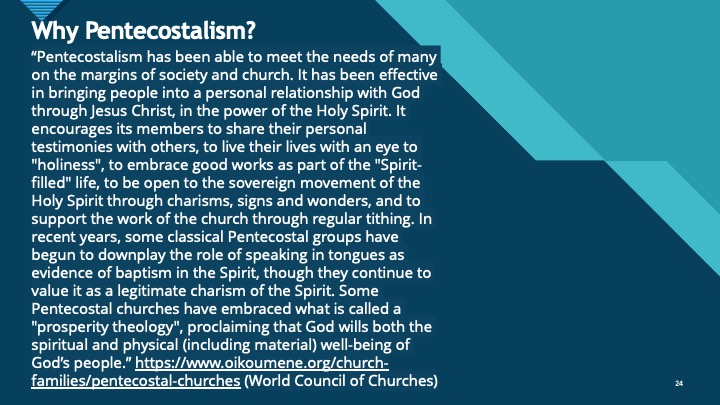

Rise of Pentecostalism 1
Links
< Home Page > < Rise of Pentecostalism Menu > < Top of Page >
Rise of Pentecostalism 1 - the Text
Its History, Beliefs, and Memorable Preachers
Introduction
• The Dictionary of Christianity in America says that Pentecostalism was perhaps “the singe-most-significant development in twentieth-century Christianity.”
• The largest church in the world is a Pentecostal church in Seoul, Korea. Average weekly attendance is 480,000 (not a typo!) The Yoido Full Gospel Church is affiliated with the Assemblies of God and was founded in 1958.
• Pentecostalism is the fastest growing family of world Christianity, with a worldwide membership of approximately 280 million, second only to Roman Catholicism.
History of Pentecostalism: Acts 2
• Of course, the very name calls us back to the book of Acts and the descent of the Holy Spirit at Pentecost:
2 When the day of Pentecost had come, they were all together in one place. 2 And suddenly from heaven there came a sound like the rush of a violent wind, and it filled the entire house where they were sitting. 3 Divided tongues, as of fire, appeared among them, and a tongue rested on each of them. 4 All of them were filled with the Holy Spirit and began to speak in other languages, as the Spirit gave them ability.
• In keeping with its Acts 2 origins, Pentecostalism is a charismatic form of Christianity emphasizing direct personal experience of God through baptism with the Holy Spirit. Along with baptism by water, this enables a Christian to live a life filled and empowered by the Spirit.
• Empowerment includes use of spiritual gifts, including speaking in tongues and divine healing.
History of Pentecostalism: Holiness Roots
The Holiness Movement
• Emerged from Methodist background in 19th century America; John Wesley taught that Christians could increasingly grow in holiness and reach a state of “entire sanctification” (though he allowed for unintentional sins)
• Places great emphasis on personal holiness; Christians can achieve perfect or full sanctification during their lifetime because of second sealing/blessing of the Holy Spirit
• Key scripture is 1 Peter 1:15-16: “as he who called you is holy, you also be holy in your conduct, since it is written, ‘You shall be holy, for I am holy.’” [Leviticus 11:44]
• Main proponent and founder of Holiness Movement and Church was Phoebe Palmer
• Often preached in Methodist churches and camp meetings
• Believed she experienced complete sanctification in 1837
• “Considered the link between Wesleyan revivalism and modern Pentecostalism” (Christianity Today’s Christian History)
History of Pentecostalism: Holiness Doctrine
The Holiness Movement
• Movement grew from Holiness Camp Meetings which began in 1867 in Vineland, New Jersey
• Eventually broke away from Methodists, who felt they focused too much on emotions
• Major denominations are Church of the Nazarene and the Salvation Army
• Doctrine is mainly orthodox Christianity except in areas of perfect sanctification and “second blessing” of Holy Spirit after salvation
The “Father of Pentecostalism”: Charles Fox Parham (1873-1929)
• A Midwesterner - born in Iowa, but family soon moved to Kansas
• Like other Methodists, believed sanctification was second work of grace, separate from salvation
• Also adopted more radical Holiness belief in a third experience – “baptism with the Holy Ghost and fire”
• Claimed that glossolalia – speaking in unknown or foreign tongues – should accompany baptism in the Holy Spirit
• Left Methodist church; missing element in Methodism was speaking in tongues as evidence of baptism of the Holy Spirit
• Moved from Kansas to Texas in 1905; set up a non-credit Bible school
William Seymour (1870-1922)
• 1905: Attended Parham’s Bible school in Houston; as a black in Jim Crow South, could only take part in Bible studies by sitting in hall outside Parham’s classroom
• After a few weeks, received invitation to help Julia Hutchins pastor small Los Angeles church of Baptists expelled from denomination for espousing Holiness doctrines
• 35 years old; son of slaves and former waiter; not a gifted speaker; lacked social skills; had little formal education; was blind in one eye; had never spoken in tongues but became “prophet of Pentecost to Los Angeles”!
• After preaching that tongues was “Bible evidence” of baptism in the Spirit, was locked out by pastor Hutchins; conducted ministry from home of Edward Lee, where he was boarding
• When Lee home grew too small for interracial crowd that gathered for Seymour’s Bible studies and prayer meetings, moved to home of Richard and Ruth Asberry
• April 9, 1906: Edward Lee asked Seymour to pray for him to receive the gift of tongues; Seymour prayed, and Lee spoke in tongues
• Seymour left for Bible study and prayer meeting at Asberry home; preached on Acts 2:4 and related Lee’s experience
• Jennie Moore, Seymour’s future wife, improvised a tune on the piano and sang in what she thought was Hebrew
• Seymour received his personal Pentecost and spoke in tongues, as did several others
William Seymour and Azusa Street
• When front porch of Asberry home collapsed from weight of crowds, negotiated a lease for former Stevens African Methodist Episcopal Church at 312 Azusa Street; became Apostolic Faith Mission
• Los Angeles Times reporter called church a “tumble-down shack” where “colored people and a sprinkling of whites” practice the “most fanatical rites, preach the wildest theories, and work themselves into a state of mad excitement in their peculiar zeal.” Also commented on Seymour: “An old colored exhort [he was only 35, remember] blind in one eye, is the majordomo of the company.”
• From Christianity Today’s Christian History:
• What happened at Azusa Street during the next three years was to change the course of church history. Although the little frame building measured only 40 by 60 feet, as many as 600 persons jammed inside while hundreds more looked in through the windows. The central attraction was tongues, with the addition of traditional black worship styles that included shouting, trances, and the holy dance. There was no order of service, since "the Holy Ghost was in control." No offerings were taken, although a box hung on the wall proclaimed, "Settle with the Lord." Altar workers enthusiastically prayed seekers through to the coveted tongues experience. It was a noisy place, and services lasted into the night.
• From the introduction by Dr. Vinson Synan, leading historian of the Pentecostal movement, to Azusa Street, journalist Frank Bartleman’s eyewitness account of the revival:
• As the revival continued for three and one-half years at Azusa, services were held three times a day – morning, afternoon, and night. Tongues speaking was the central attraction, but healing of the sick was not far behind. The walls were soon covered with the crutches and canes of those who were miraculously healed. The gift of tongues was soon followed by the gift of interpretation. As time passed Seymour and his followers claimed that all the gifts of the Spirit had been restored to the church.
Frank Bartleman’s Azusa Street
Frank Bartleman’s eyewitness reports were printed and reprinted in the Holiness press, drawing an avalanche of “Azusa Pilgrims.” The following excerpts are from Bartleman’s book, Azusa Street:
The San Francisco earthquake [April 18, 1906] was surely the voice of God to the people on the Pacific Coast. It was used mightily in conviction, for the gracious after revival. In the early “Azusa” days both Heaven and hell seemed to have come to town. Men were at the breaking point. Conviction was mightily on the people. They would fly to pieces even on the street, almost without provocation.
The work was getting clearer and stronger at “Azusa.” God was working mightily. It seemed that everyone had to go to “Azusa.” Missionaries were gathered there from Africa, India, and the islands of the sea. Preachers and workers had crossed the continent, and come from distant islands, with an irresistible drawing to Los Angeles…. They had come up for “Pentecost,” though they little realized it. Holiness meetings, tents and missions began to close up for lack of attendance. Their people were at “Azusa.”
There was much persecution, especially from the press. They wrote us up shamefully, but this only drew the crowds. Some gave the work six months to live. Soon the meetings were running day and night. The place was packed out nightly. The whole building, upstairs and down, had now been cleared and put into use. There were far more white people than colored coming. The “color line” was washed away in the blood. [Sadly, this may only have been true in practice for a short time. Seymour later wrote by-laws that prevented anyone except African-Americans from holding office in the mission.]
William Seymour and Azusa Street
After the “glory years’” of 1906 to 1909, the Azusa Street mission became a small black church pastored by Seymour until his death on September 28, 1922, and then by his wife, Jennie, until her death in 1936. It was later sold for unpaid taxes and demolished. Today, a Japanese Cultural Center occupies the ground.
By the year 2000, the spiritual heirs of Seymour, the Pentecostals and charismatics, numbered over 500 million adherents, making it the second largest family of Christians in the world. Today, practically all Pentecostal and charismatic movements can trace their roots directly or indirectly to the humble mission on Azusa Street and its pastor.
Vinson Synan, former dean of the School of Divinity at Regent University, author of The Holiness-Pentecostal Tradition (Eerdmans 1997)
After Azusa Street: Timeline
1907: T.B Barrett opens Pentecostal meetings in Oslo; begins Pentecostal movement in Scandinavia, England, and Germany
1907: G.B. Cashwell spreads Pentecostalism in the South
1908: John G. Lake begins South African Apostolic Faith Mission
1908: Church of God (Cleveland, TN) accepts Pentecostalism under A.J. Tomlinson
1909: Luigi Francescon and Giacomo Lombardi begin Italian Pentecostal movements in U.S., Italy, Argentina, and Brazil
1909: Florence Crawford founds the Apostolic Faith Church in Portland, Oregon
1912: Maria Woodworth-Etter becomes popular Pentecostal preacher in Dallas
1914: Assemblies of God formed in Hot Springs, AR
1919: Pentecostal Assemblies of the World incorporated
1927: Aimee Semple McPherson forms International Church of the Foursquare Gospel in Los Angeles
1928: Mary Rumsey opens first Pentecostal missions in Korea and Japan
1943: American Pentecostal churches accepted as charter members of National Association of Evangelicals
After Azusa Street: Pentecostal Denominations
(1 Million+ Worldwide)
Assemblies of God – 85.4 million
Foursquare Church - 8.8 million
Church of God (Cleveland, Tennessee) - 7 million
Church of God in Christ - 6.5 million
Church of Pentecost – 3.9 million
Christian Congregation of Brazil – 2.8 million
The Pentecostal Mission – 2.5 million
International Pentecostal Holiness Church – 2 million
Universal Church of the Kingdom of God – 2 million
Church of God of Prophecy – 1.5 million
Apostolic Faith Mission of South Africa – 1.4 million
Jesus Is Lord Church Worldwide – 1 million
• Presbyterians: roughly 75 million worldwide
• Pentecostals in US: 10 million+ (approximately 5 million in Church of God in Christ and 3 million in Assemblies of God)
• PC(USA): 1.1 million
Why Pentecostalism?
“Pentecostalism has been able to meet the needs of many on the margins of society and church. It has been effective in bringing people into a personal relationship with God through Jesus Christ, in the power of the Holy Spirit. It encourages its members to share their personal testimonies with others, to live their lives with an eye to "holiness", to embrace good works as part of the "Spirit-filled" life, to be open to the sovereign movement of the Holy Spirit through charisms, signs and wonders, and to support the work of the church through regular tithing. In recent years, some classical Pentecostal groups have begun to downplay the role of speaking in tongues as evidence of baptism in the Spirit, though they continue to value it as a legitimate charism of the Spirit. Some Pentecostal churches have embraced what is called a "prosperity theology", proclaiming that God wills both the spiritual and physical (including material) well-being of God’s people.” https://www.oikoumene.org/church-families/pentecostal-churches (World Council of Churches)